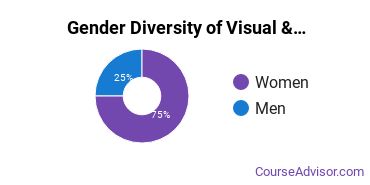Visual & Performing Arts at Stevens - The Institute of Business & Arts
What traits are you looking for in a visual & performing arts school? To help you decide if Stevens - The Institute of Business & Arts is right for you, we've gathered the following information about the school's visual & performing arts program.Siba is located in Saint Louis, Missouri and has a total student population of 109.
Want to know more about the career opportunities in this field? Check out the Careers in Visual & Performing Arts section at the bottom of this page.
Siba Visual & Performing Arts Degrees Available
- Associate’s Degree in Visual & Performing Arts
- Bachelor’s Degree in Visual & Performing Arts
Siba Visual & Performing Arts Rankings
The visual & performing arts major at Siba is not ranked on College Factual’s Best Colleges and Universities for Visual & Performing Arts. This could be for a number of reasons, such as not having enough data on the major or school to make an accurate assessment of its quality.
Visual & Performing Arts Student Demographics at Siba
Take a look at the following statistics related to the make-up of the visual & performing arts majors at Stevens - The Institute of Business & Arts.
Siba Visual & Performing Arts Associate’s Program

Siba does a better job with serving racial-ethnic minorities than the typical school does. Its associate's program in visual & performing arts graduates 49% more racial-ethnic minorities than the nationwide average.*
The following table and chart show the race/ethnicity for students who recently graduated from Stevens - The Institute of Business & Arts with a associate's in visual & performing arts.

| Race/Ethnicity | Number of Students |
|---|---|
| Asian | 0 |
| Black or African American | 7 |
| Hispanic or Latino | 0 |
| White | 1 |
| International Students | 0 |
| Other Races/Ethnicities | 0 |
Siba Visual & Performing Arts Bachelor’s Program

Prospective students may be interested in knowing that this school graduates 12% more racial-ethnic minorities in its visual & performing arts bachelor's program than the national average.*
The following table and chart show the race/ethnicity for students who recently graduated from Stevens - The Institute of Business & Arts with a bachelor's in visual & performing arts.

| Race/Ethnicity | Number of Students |
|---|---|
| Asian | 0 |
| Black or African American | 4 |
| Hispanic or Latino | 0 |
| White | 4 |
| International Students | 0 |
| Other Races/Ethnicities | 0 |
Concentrations Within Visual & Performing Arts
If you plan to be a visual & performing arts major, you may want to focus your studies on one of the following concentrations. The table shows all degrees awarded in this field awarded for all degree levels at Stevens - The Institute of Business & Arts. A concentration may not be available for your level.
| Concentration | Annual Degrees Awarded |
|---|---|
| Design & Applied Arts | 11 |
Careers That Visual & Performing Arts Grads May Go Into
A degree in visual & performing arts can lead to the following careers. Since job numbers and average salaries can vary by geographic location, we have only included the numbers for MO, the home state for Stevens - The Institute of Business & Arts.
| Occupation | Jobs in MO | Average Salary in MO |
|---|---|---|
| High School Teachers | 27,930 | $54,280 |
| Managers | 3,980 | $97,820 |
| Graphic Designers | 3,740 | $50,350 |
| Producers and Directors | 1,610 | $65,560 |
| Art, Drama, and Music Professors | 1,430 | $80,570 |
References
*The racial-ethnic minorities count is calculated by taking the total number of students and subtracting white students, international students, and students whose race/ethnicity was unknown. This number is then divided by the total number of students at the school to obtain the racial-ethnic minorities percentage.
More about our data sources and methodologies.
